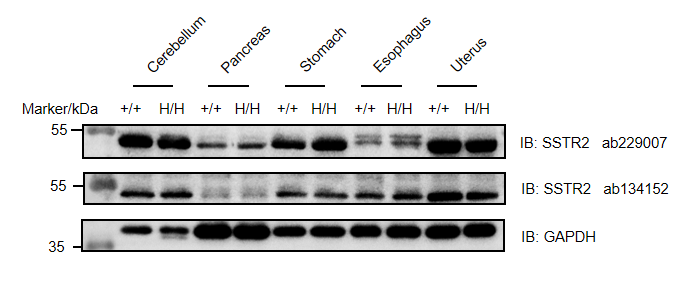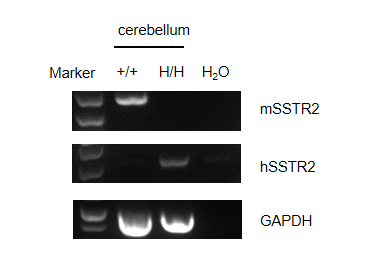中文
B-hSSTR2 mice
| Strain Name | C57BL/6-Sstr2tm1(SSTR2)Bcgen/Bcgen | Common Name | B-hSSTR2 mice |
| Background | C57BL/6 | Catalog number |
111157 |
|
Aliases |
SS2R; sst2; SRIF-1; SSTR-2; Smstr2; Smstr-2 | ||
模型验证
Description

- Somatostatin Receptor 2 (SSTR2) is one of five 7-transmembrane G-protein-coupled receptors for somatostatins 14 and 28. Human SSTR2 shares 84% aa identity with mouse SSTR2 within the extracellular domains. Isoform B (357 aa) has an alternate C-terminal cytoplasmic region that is 12 aa shorter than that of isoform A (369 aa, reported as 93 kDa). Both are expressed in brain, stomach, intestinal epithelia, pancreatic islets and kidney tubules. Isoform B is also expressed in parotid, thyroid and bronchial glands.
- The exon 2 of mouse Sstr2 gene that encode the extracellular and transmembrane domains was replaced by human SSTR2 exon 2 in B-hSSTR2 mice.
- Mouse Sstr2 mRNA was detectable in cerebellum of wild-type C57BL/6 mice. Human SSTR2 mRNA was detectable in homozygous B-hSSTR2 mice.
- Human SSTR2 was detectable in cerebellum, pancreas, stomach, esophagus and uterus of homozygous B-hSSTR2 mice.
- Application: This product is used for the efficacy evaluation and safety evaluation of drugs for the treatment of neuroendocrine tumors.
mRNA expression analysis

Strain specific analysis of SSTR2 mRNA expression in wild-type C57BL/6 mice and B-hSSTR2 mice by RT-PCR. Cerebellum RNA were isolated from wildtype C57BL/6 mice (+/+) and homozygous B-hSSTR2 mice (H/H), then cDNA libraries were synthesized by reverse transcription, followed by PCR with mouse or human SSTR2 primers. Mouse Sstr2 mRNA was only detectable in wild-type C57BL/6 mice. Human SSTR2 mRNA was only detectable in homozygous B-hSSTR2 mice.
Protein expression analysis

Western blot analysis of SSTR2 protein expression in homozygous B-hSSTR2 mice. Various tissue lysates were collected from wild-type C57BL/6N (+/+) mice and homozygous B-hSSTR2 mice (H/H), and then analyzed by western blot with anti-SSTR2 antibody. 40 μg total proteins were loaded for western blotting analysis. SSTR2 was detected in cerebellum, pancreas, stomach, esophagus, uterus and colon.
Copyright © 2024 百奥赛图江苏基因生物技术有限公司. All Rights Reserved
备案号: 苏ICP备2021053911号-1
 苏公网安备:32068402320845号
网站建设:北京分形科技
苏公网安备:32068402320845号
网站建设:北京分形科技
 苏公网安备:32068402320845号
网站建设:北京分形科技
苏公网安备:32068402320845号
网站建设:北京分形科技






 010-56967680
010-56967680 info@bbctg.com.cn
info@bbctg.com.cn